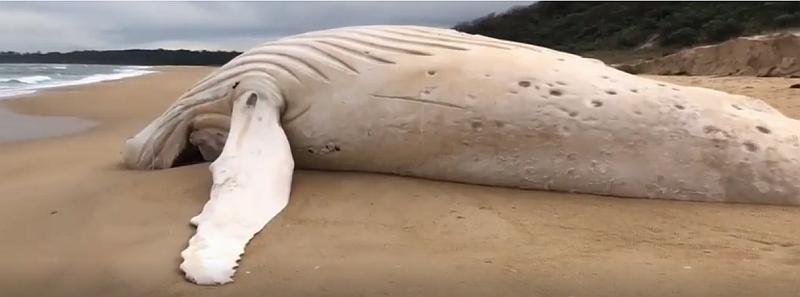 A ten-meter-long white humpback whale carcass recently washed ashore on Australia’s Mallacoota beach raising fears that it could be the world-famous albino humpback nicknamed Migaloo.
A ten-meter-long white humpback whale carcass recently washed ashore on Australia’s Mallacoota beach raising fears that it could be the world-famous albino humpback nicknamed Migaloo.
A closer examination by Victoria’s Department of Environment, Land, Water, and Planning revealed, however, that the dead whale is a “sub-adult female.” Migaloo is an adult male humpback. Migaloo is also larger at around fifteen meters long. It is also unclear whether the dead whale is indeed white or whether the apparent lack of pigmentation is due to bleaching.
A necropsy will be performed on the carcass to investigate its premature death and to determine whether there are plastics in its stomach or high levels of toxins.
Migaloo was first spotted off Byron Bay, Queensland in 1991. Named by elders of the local aboriginal collective in Hervey Bay, Migaloo means “white fella.”
In 1993 Pacific Whale Foundation researchers encountered the white whale in Hervey Bay, Queensland. During this encounter, they were able to confirm the whale was all white and in 1998 were able to record the whale singing, a trait distinct to male humpback whales. Genetic testing in 2004 by Southern Cross University scientists further confirmed that Migaloo is a male.
For the past several decades, Migaloo has migrated with other humpback whales in the south Pacific, swimming north along Australia’s east coast each year to the Great Barrier Reef where the mating and birthing grounds are between June to August, then back southwards from September to November.
Migaloo is generally sighted between Cooktown and Sydney on the Australian coast but has occasionally been sighted off New Zealand.
In recent years there have been concerns raised over the white whale’s health. Migaloo’s albinism may have made the humpback susceptible to skin cancer. Red marks observed on the humpback whale’s dorsal fin caused worries that Migaloo may have early-stage cancer.
In June last year, Olaf Meynecke, a researcher at Griffith University, said that at the last confirmed sighting in 2020, Migaloo had looked unwell.
“He started moving down south at the end of July and it was a little bit out of his normal movement pattern. He made a pretty fast turn down south.
“The photos showed that there were some changes in the skin coloration and he generally didn’t look too well.”
So, where is he? Just because he has not been seen in a few years, does not necessarily mean he is dead.
Newsweek quotes whale biologist Vanessa Pierotta from an article for the Conversation, noting that Migaloo might migrate later than expected, or go a different way to normal.
“Migaloo’s presence may be driven by several factors,” she wrote. “This includes social circumstances, such as interactions with other whales (including moving between different pods) or biological needs (the desire to head north to reproduce).”
Sometimes humpbacks choose to not migrate at all some years, staying in the Southern Ocean.
